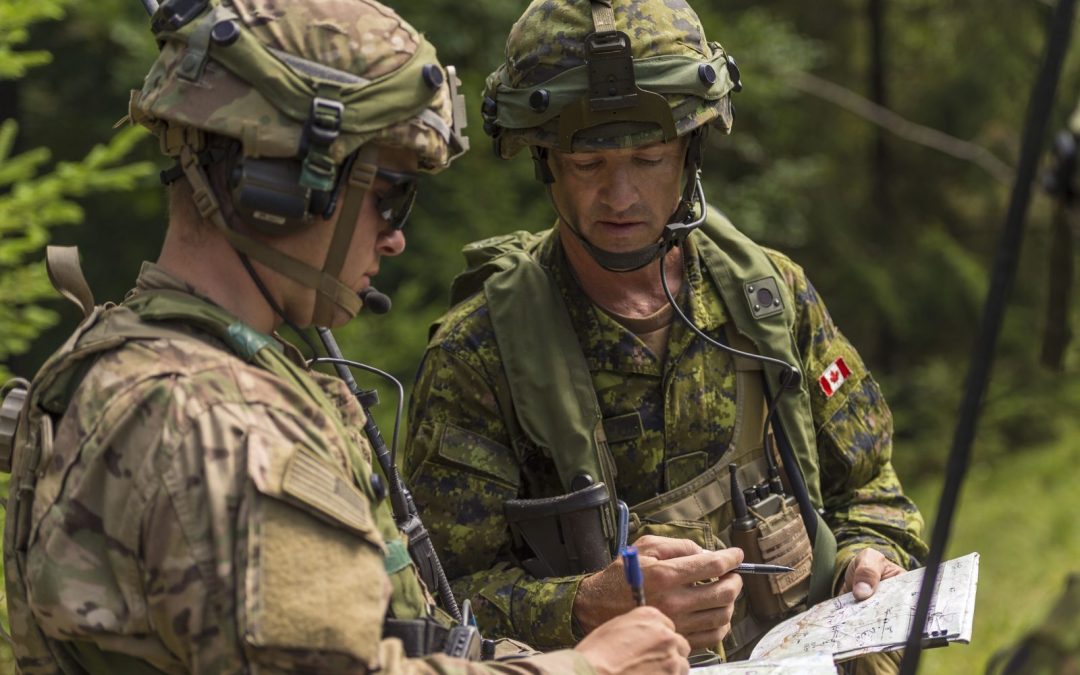by Anthony Seaboyer, Mike Rostek, Nancy Teeple, Ali Dizboni, and Yazan Qasrawi
Military strategy increasingly relies on multinational alliances and coalitions to broaden capabilities, increase legitimacy, and deter conflict. Multinational interoperability is therefore critical to military effectiveness. Thus, the American, British, Canadian, Australian, and New Zealand (ABCANZ) Armies Program (AAP) has committed to achieving integrated interoperability by the year 2027.
In support of this effort, the Canadian Army Land Warfare Centre (CALWC) hosted the ABCANZ Biennial Event 2022 (BA 22) from December 6 to 8, 2022, the culmination of a year-long research project on interoperability in the human domain. The research conducted in support of BA 22 was a collaboration of over 40 subject matter experts from the ABCANZ nations.
Interoperability can be viewed across three broad pillars: technical, procedural, and human. The AAP’s means to measure interoperability within the human pillar is nascent. This prevents the identification of human interoperability gaps, as well as any ability to assess meaningfully and systematically the level of interoperability across this vital pillar.
BA 22 aimed to enhance the ability of the AAP to assess the human domain of interoperability among ABCANZ armies based on an agreed upon common lexicon, a deeper understanding of the aspects of the human pillar of interoperability, and the design of a measurement tool for assessing human interoperability.
The research team identified that the U.S. Army Interoperability Measurement System (AIMS) is the only interoperability measurement tool currently in use by allied militaries. AIMS is a tool designed to support U.S. Army interoperability objectives and planning. The goal of AIMS is to provide an objective measure of interoperability levels between the U.S. and a multinational partner or multiple partners.
The AIMS tool is designed to function with a variety of data input methods to meet the needs of the collection team. It is used to measure interoperability at the brigade level and above.
While AIMS reflects significant progress in assessing technical and procedural interoperability, human interoperability remains far less clearly conceptualized and not measured to the extent of the other domains. With the official adoption of AIMS by ABCANZ, the AAP has now advanced a common tool to assess interoperability.
Adapting existing measures of relevant constructs, the ABCANZ BA22 research team developed the first ever independently-developed tool designed to measure human interoperability among ABCANZ Armies: the Human Domain of Interoperability Survey (HDIS). The HDIS systematically assesses human interoperability in multinational (MN) exercises, taking inspiration from tools already tested in an army context by measuring indicators of human interoperability.
To design HDIS, the research team identified indicators of, and potential obstacles to, human interoperability, with a focus on the role of trust and culture. Trust, culture, and the quality of interactions were selected as the concepts that are most relevant to the ABCANZ community because they are key determinants of interoperability in any coalition or alliance and are at the same time operationalizable for the measurement of interoperability in the human domain.
The HDIS is designed to elicit responses regarding individual experiences, perceptions, and expectations of human interactions in a MN military environment, in order to inform a wider and deeper understanding of interoperability between MN partners. HDIS is designed to be compatible with AIMS, to enable its integration within AIMS in the future if required.
The HDIS was very well received by ABCANZ, particularly regarding how the methodological approach links the moral and ethical spheres of armies to the fighting power construct as well as operational outcomes.
The HDIS’s potential has generated interest within NATO, as it may be tailored to study interoperability within other alliances and coalitions’ armies, as well as air and maritime forces.
In addition to the positive outcomes of the ABCANZ BA22 project, the research team made the recommendations that research should explore more precisely how to distinguish levels of human interoperability.
While the research team proposed definitions for human interoperability that are aligned with the existing levels of interoperability (not interoperable, deconflicted, compatible, and integrated), more research is needed to refine and operationalize the existing categories. Further research should also examine interrelationships among different domains of interoperability (human, procedural, and technical).
Anthony Seaboyer and Dr. Ali Ghanbarpour-Dizboni are with the Royal Military College of Canada, Dr. Michael Rostek is with Defence Research and Development Canada’s (DRDC) Toronto Research Centre, and Dr. Yazan Qasrawi and Dr. Nancy Teeple are with DRDC’s Centre for Operational Research and Analysis (CORA). (Other subject experts on the project included Dr. Katherine Banko from DRDC CORA, Dr. Angela Febbraro and Dr. Megan Thompson from DRDC Toronto, Dr. Irina Goldenberg from Director General Military Personnel Research and Analysis, Dr. Allison Abbe, Professor of Organizational Studies at the U.S. Army War College. Dr. Kerry Fosher, Director of Research, Marine Corps University, Quantico, Virginia; Erica Dill-Russell from the Defence Technology Agency Operations Analysis Section, NZDF. Active military expertise was provided by LTC Darren Woods (UK, ABCANZ Program Office), LTC Dale T. Verran (US, Chief Unified Action Partner (UAP) Interoperability), LCol Ted Underhill (CDN, Interoperability Coordinator, CALWC), Maj Nick Hammond (UK, SO2 Interoperability) and Maj Sean McDonaugh (CDN, SO Interoperability, CALWC).)




